transmission MITSUBISHI SHOGUN 2017 Owner's Manual (in English)
[x] Cancel search | Manufacturer: MITSUBISHI, Model Year: 2017, Model line: SHOGUN, Model: MITSUBISHI SHOGUN 2017Pages: 394, PDF Size: 19 MB
Page 2 of 394
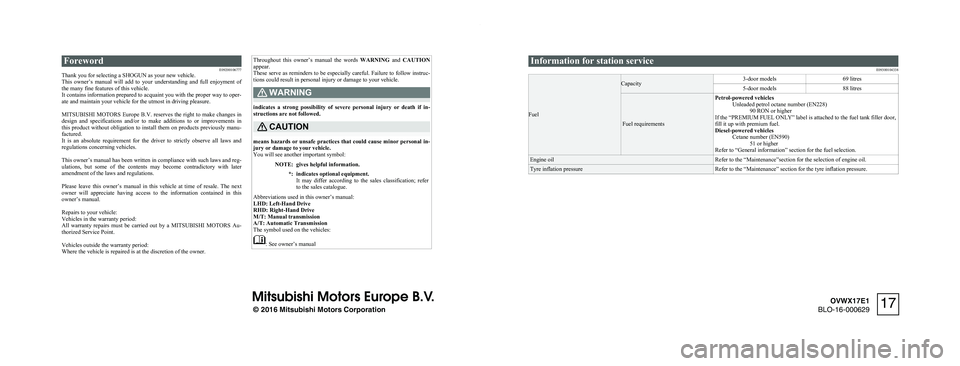
ForewordE09200106777
Thank you for selecting a SHOGUN as your new vehicle.
This owner’s manual will add to your understanding and full enjoyment of
the many fine features of this vehicle.
It contains information prepared to acquaint you with the proper way to oper-
ate and maintain your vehicle for the utmost in driving pleasure.
MITSUBISHI MOTORS Europe B.V. reserves the right to make changes in
design and specifications and/or to make additions to or improvements in
this product without obligation to install them on products previously manu- factured.
It is an absolute requirement for the driver to strictly observe all laws and
regulations concerning vehicles.
This owner’s manual has been written in compliance with such laws and reg- ulations, but some of the contents may become contradictory with later amendment of the laws and regulations.
Please leave this owner’s manual in this vehicle at time of resale. The next
owner will appreciate having access to the information contained in this
owner’s manual.
Repairs to your vehicle:
Vehicles in the warranty period:
All warranty repairs must be carried out by a MITSUBISHI MOTORS Au-
thorized Service Point.
Vehicles outside the warranty period:
Where the vehicle is repaired is at the discretion of the owner.
Throughout this owner’s manual the words WARNING and CAUTION
appear.
These serve as reminders to be especially careful. Failure to follow instruc-
tions could result in personal injury or damage to your vehicle.WARNING
indicates a strong possibility of severe personal injury or death if in- structions are not followed.
CAUTION
means hazards or unsafe practices that could cause minor personal in-
jury or damage to your vehicle.
You will see another important symbol:
NOTE:gives helpful information.*:indicates optional equipment.
It may differ according to the sales classification; refer to the sales catalogue.
Abbreviations used in this owner’s manual:
LHD: Left-Hand Drive
RHD: Right-Hand Drive
M/T: Manual transmission
A/T: Automatic Transmission
The symbol used on the vehicles:
: See owner’s manual
Information for station service
E09300104338
Fuel
Capacity3-door models69 litres5-door models88 litres
Fuel requirements
Petrol-powered vehiclesUnleaded petrol octane number (EN228)90 RON or higher
If the “PREMIUM FUEL ONLY” label is attached to the fuel tank filler door,
fill it up with premium fuel.
Diesel-powered vehicles Cetane number (EN590)51 or higher
Refer to “General information” section for the fuel selection.Engine oilRefer to the “Maintenance”section for the selection of engine oil.Tyre inflation pressureRefer to the “Maintenance” section for the tyre inflation pressure.
© 2016 Mitsubishi Motors Corporation
17
OVWX17E1
BLO-16-000629
Page 16 of 394
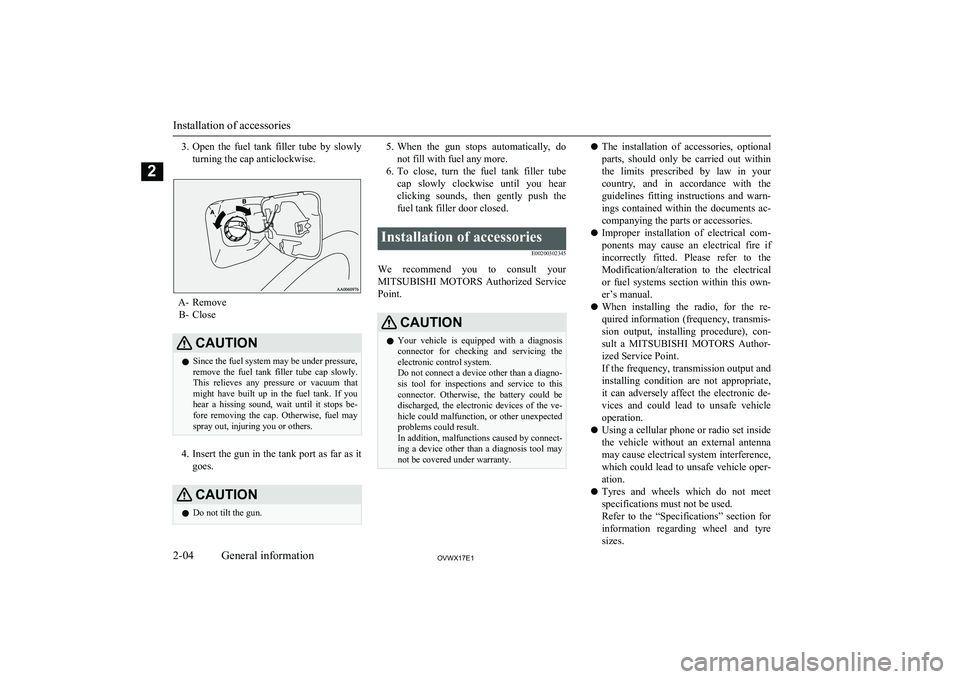
3.Open the fuel tank filler tube by slowly
turning the cap anticlockwise.
A- Remove B- Close
CAUTIONl Since the fuel system may be under pressure,
remove the fuel tank filler tube cap slowly. This relieves any pressure or vacuum that
might have built up in the fuel tank. If you
hear a hissing sound, wait until it stops be- fore removing the cap. Otherwise, fuel may
spray out, injuring you or others.
4. Insert the gun in the tank port as far as it
goes.
CAUTIONl Do not tilt the gun.5.
When the gun stops automatically, do
not fill with fuel any more.
6. To close, turn the fuel tank filler tube
cap slowly clockwise until you hear clicking sounds, then gently push the
fuel tank filler door closed.Installation of accessories
E00200302345
We recommend you to consult yourMITSUBISHI MOTORS Authorized Service
Point.
CAUTIONl Your vehicle is equipped with a diagnosis
connector for checking and servicing theelectronic control system.
Do not connect a device other than a diagno-
sis tool for inspections and service to this connector. Otherwise, the battery could be
discharged, the electronic devices of the ve- hicle could malfunction, or other unexpected
problems could result.
In addition, malfunctions caused by connect-
ing a device other than a diagnosis tool may not be covered under warranty.l The installation of accessories, optional
parts, should only be carried out within
the limits prescribed by law in your
country, and in accordance with the guidelines fitting instructions and warn-
ings contained within the documents ac-
companying the parts or accessories.
l Improper installation of electrical com-
ponents may cause an electrical fire if
incorrectly fitted. Please refer to the Modification/alteration to the electrical
or fuel systems section within this own-
er’s manual.
l When installing the radio, for the re-
quired information (frequency, transmis-
sion output, installing procedure), con- sult a MITSUBISHI MOTORS Author-
ized Service Point.
If the frequency, transmission output and installing condition are not appropriate,
it can adversely affect the electronic de- vices and could lead to unsafe vehicle operation.
l Using a cellular phone or radio set inside
the vehicle without an external antenna
may cause electrical system interference, which could lead to unsafe vehicle oper-ation.
l Tyres and wheels which do not meet
specifications must not be used.
Refer to the “Specifications” section for
information regarding wheel and tyre
sizes.
Installation of accessories
2-04OVWX17E1General information2
Page 99 of 394
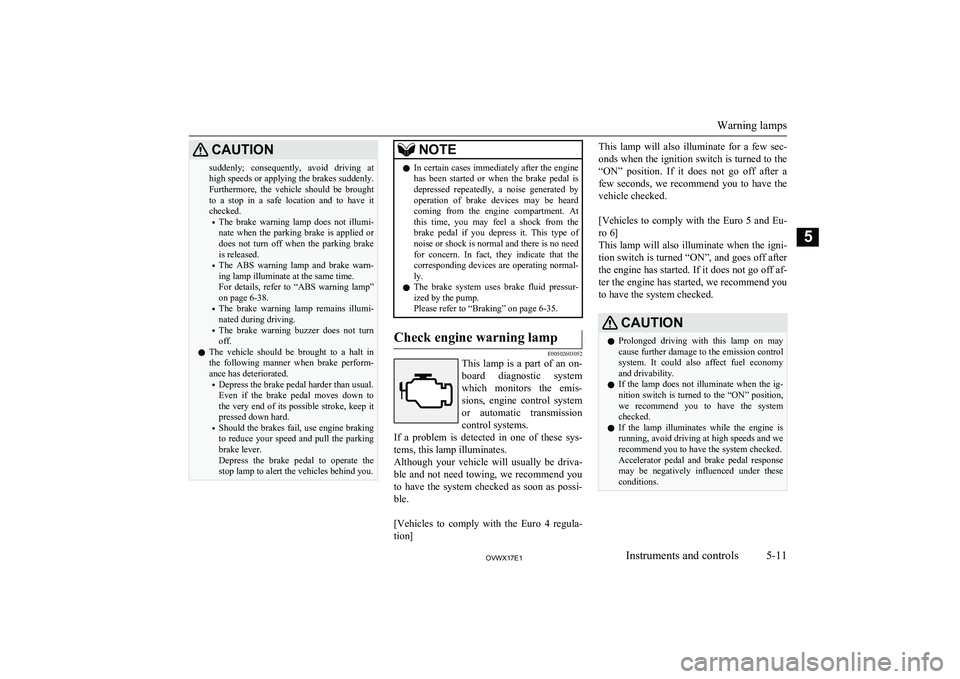
CAUTIONsuddenly; consequently, avoid driving athigh speeds or applying the brakes suddenly.
Furthermore, the vehicle should be brought
to a stop in a safe location and to have it checked.
• The brake warning lamp does not illumi-
nate when the parking brake is applied ordoes not turn off when the parking brake
is released.
• The ABS warning lamp and brake warn-
ing lamp illuminate at the same time.
For details, refer to “ABS warning lamp” on page 6-38.
• The brake warning lamp remains illumi-
nated during driving.
• The brake warning buzzer does not turn
off.
l The vehicle should be brought to a halt in
the following manner when brake perform-
ance has deteriorated.
• Depress the brake pedal harder than usual.
Even if the brake pedal moves down to
the very end of its possible stroke, keep it pressed down hard.
• Should the brakes fail, use engine braking
to reduce your speed and pull the parking
brake lever.
Depress the brake pedal to operate the
stop lamp to alert the vehicles behind you.NOTEl In certain cases immediately after the engine
has been started or when the brake pedal is
depressed repeatedly, a noise generated by operation of brake devices may be heard coming from the engine compartment. At
this time, you may feel a shock from the brake pedal if you depress it. This type of
noise or shock is normal and there is no need for concern. In fact, they indicate that the
corresponding devices are operating normal- ly.
l The brake system uses brake fluid pressur-
ized by the pump.
Please refer to “Braking” on page 6-35.Check engine warning lamp
E00502603052
This lamp is a part of an on-
board diagnostic system
which monitors the emis-
sions, engine control system or automatic transmission
control systems.
If a problem is detected in one of these sys-
tems, this lamp illuminates.
Although your vehicle will usually be driva-
ble and not need towing, we recommend you to have the system checked as soon as possi-
ble.
[Vehicles to comply with the Euro 4 regula-
tion]
This lamp will also illuminate for a few sec-
onds when the ignition switch is turned to the
“ON” position. If it does not go off after a few seconds, we recommend you to have the vehicle checked.
[Vehicles to comply with the Euro 5 and Eu-
ro 6]
This lamp will also illuminate when the igni-
tion switch is turned “ON”, and goes off after the engine has started. If it does not go off af- ter the engine has started, we recommend youto have the system checked.CAUTIONl Prolonged driving with this lamp on may
cause further damage to the emission control system. It could also affect fuel economy
and drivability.
l If the lamp does not illuminate when the ig-
nition switch is turned to the “ON” position,
we recommend you to have the system
checked.
l If the lamp illuminates while the engine is
running, avoid driving at high speeds and we recommend you to have the system checked.
Accelerator pedal and brake pedal response may be negatively influenced under these
conditions.
Warning lamps
5-11OVWX17E1Instruments and controls5
Page 139 of 394
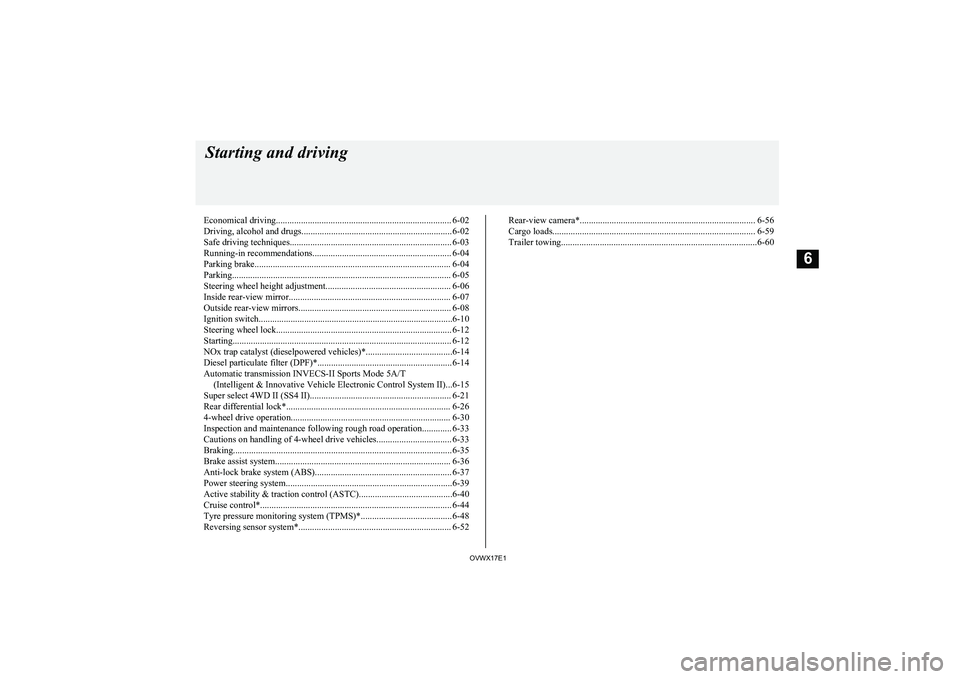
Economical driving............................................................................. 6-02
Driving, alcohol and drugs.................................................................. 6-02
Safe driving techniques....................................................................... 6-03
Running-in recommendations............................................................. 6-04 Parking brake...................................................................................... 6-04
Parking................................................................................................ 6-05
Steering wheel height adjustment....................................................... 6-06
Inside rear-view mirror....................................................................... 6-07 Outside rear-view mirrors................................................................... 6-08
Ignition switch.....................................................................................6-10 Steering wheel lock............................................................................. 6-12
Starting................................................................................................ 6-12 NOx trap catalyst (dieselpowered vehicles)*......................................6-14
Diesel particulate filter (DPF)*........................................................... 6-14 Automatic transmission INVECS-II Sports Mode 5A/T (Intelligent & Innovative Vehicle Electronic Control System II)...6-15
Super select 4WD II (SS4 II).............................................................. 6-21
Rear differential lock*........................................................................ 6-26 4-wheel drive operation...................................................................... 6-30
Inspection and maintenance following rough road operation............. 6-33
Cautions on handling of 4-wheel drive vehicles................................. 6-33
Braking................................................................................................ 6-35
Brake assist system............................................................................. 6-36
Anti-lock brake system (ABS)............................................................ 6-37
Power steering system.........................................................................6-39
Active stability & traction control (ASTC).........................................6-40
Cruise control*.................................................................................... 6-44
Tyre pressure monitoring system (TPMS)*........................................ 6-48 Reversing sensor system*................................................................... 6-52Rear-view camera*............................................................................. 6-56
Cargo loads......................................................................................... 6-59Trailer towing......................................................................................6-60Starting and driving
OVWX17E16
Page 153 of 394
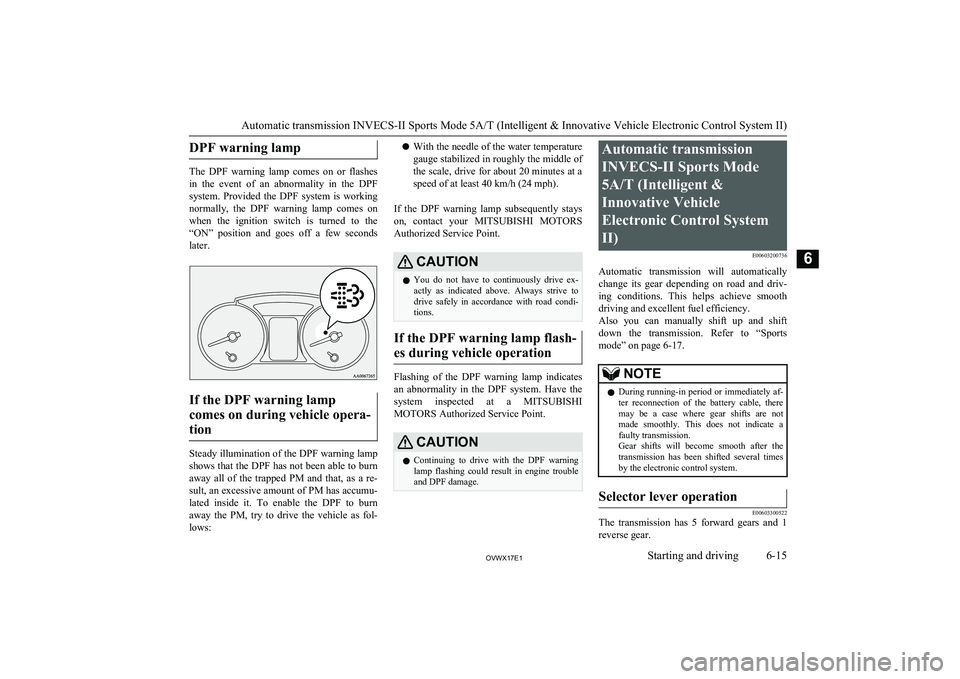
DPF warning lamp
The DPF warning lamp comes on or flashes
in the event of an abnormality in the DPF
system. Provided the DPF system is working normally, the DPF warning lamp comes on when the ignition switch is turned to the
“ON” position and goes off a few seconds later.
If the DPF warning lamp
comes on during vehicle opera- tion
Steady illumination of the DPF warning lamp shows that the DPF has not been able to burn
away all of the trapped PM and that, as a re-
sult, an excessive amount of PM has accumu- lated inside it. To enable the DPF to burn
away the PM, try to drive the vehicle as fol-
lows:
l With the needle of the water temperature
gauge stabilized in roughly the middle of the scale, drive for about 20 minutes at a
speed of at least 40 km/h (24 mph).
If the DPF warning lamp subsequently stays
on, contact your MITSUBISHI MOTORS
Authorized Service Point.CAUTIONl You do not have to continuously drive ex-
actly as indicated above. Always strive todrive safely in accordance with road condi-
tions.
If the DPF warning lamp flash-
es during vehicle operation
Flashing of the DPF warning lamp indicates an abnormality in the DPF system. Have the system inspected at a MITSUBISHI
MOTORS Authorized Service Point.
CAUTIONl Continuing to drive with the DPF warning
lamp flashing could result in engine trouble
and DPF damage.Automatic transmission
INVECS-II Sports Mode5A/T (Intelligent &
Innovative Vehicle
Electronic Control System
II) E00603200736
Automatic transmission will automatically
change its gear depending on road and driv- ing conditions. This helps achieve smooth
driving and excellent fuel efficiency.
Also you can manually shift up and shift down the transmission. Refer to “Sports
mode” on page 6-17.NOTEl During running-in period or immediately af-
ter reconnection of the battery cable, there may be a case where gear shifts are not
made smoothly. This does not indicate a faulty transmission.
Gear shifts will become smooth after the transmission has been shifted several times
by the electronic control system.Selector lever operation
E00603300522
The transmission has 5 forward gears and 1
reverse gear.
Automatic transmission INVECS-II Sports Mode 5A/T (Intelligent & Innovative Vehicle Electronic Control System II)
6-15OVWX17E1Starting and driving6
Page 154 of 394
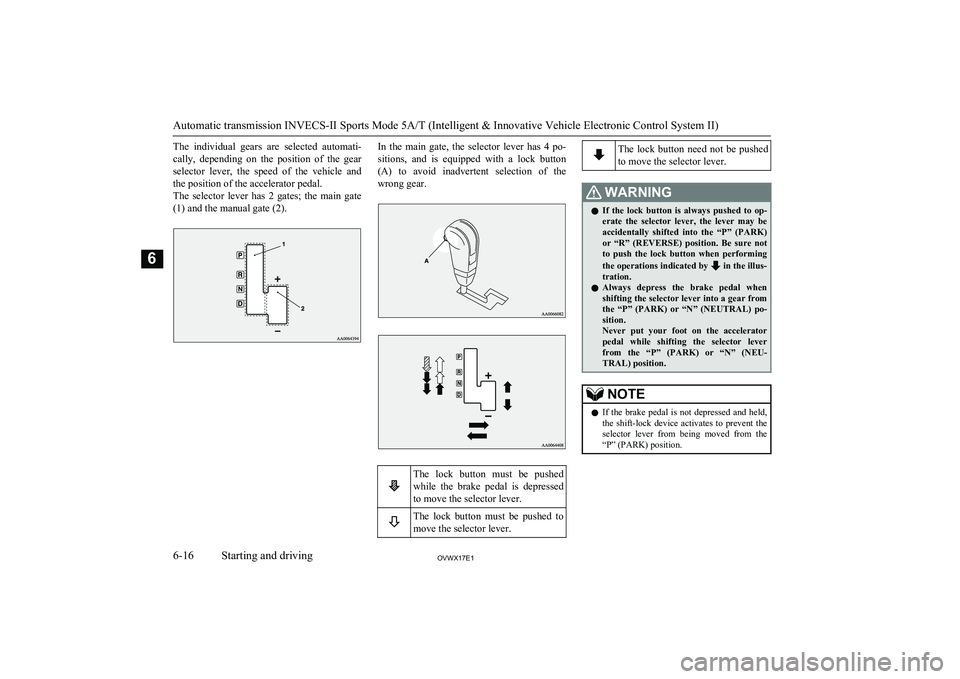
The individual gears are selected automati-cally, depending on the position of the gear selector lever, the speed of the vehicle and
the position of the accelerator pedal.
The selector lever has 2 gates; the main gate
(1) and the manual gate (2).In the main gate, the selector lever has 4 po- sitions, and is equipped with a lock button
(A) to avoid inadvertent selection of the wrong gear.The lock button must be pushed
while the brake pedal is depressed to move the selector lever.The lock button must be pushed tomove the selector lever.The lock button need not be pushed to move the selector lever.WARNINGl If the lock button is always pushed to op-
erate the selector lever, the lever may beaccidentally shifted into the “P” (PARK)
or “R” (REVERSE) position. Be sure not to push the lock button when performing
the operations indicated by
in the illus-
tration.
l Always depress the brake pedal when
shifting the selector lever into a gear from the “P” (PARK) or “N” (NEUTRAL) po-sition.
Never put your foot on the accelerator
pedal while shifting the selector lever
from the “P” (PARK) or “N” (NEU- TRAL) position.
NOTEl If the brake pedal is not depressed and held,
the shift-lock device activates to prevent the
selector lever from being moved from the “P” (PARK) position.
Automatic transmission INVECS-II Sports Mode 5A/T (Intelligent & Innovative Vehicle Electronic Control System II)
6-16OVWX17E1Starting and driving6
Page 155 of 394
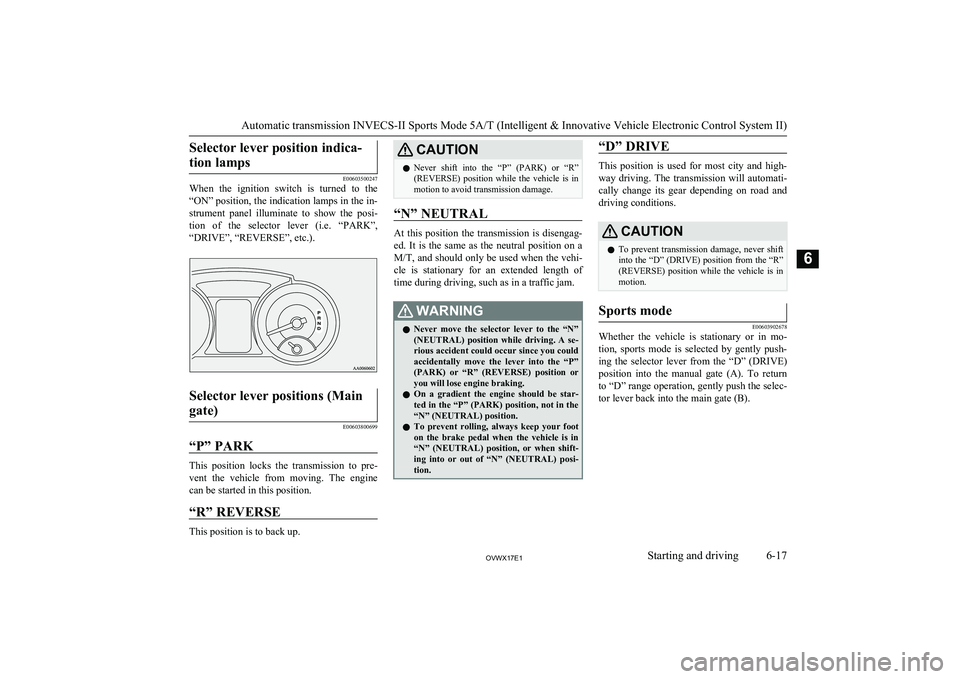
Selector lever position indica-tion lamps
E00603500247
When the ignition switch is turned to the
“ON” position, the indication lamps in the in- strument panel illuminate to show the posi-tion of the selector lever (i.e. “PARK”,
“DRIVE”, “REVERSE”, etc.).
Selector lever positions (Main
gate)
E00603800699
“P” PARK
This position locks the transmission to pre- vent the vehicle from moving. The engine
can be started in this position.
“R” REVERSE
This position is to back up.
CAUTIONl Never shift into the “P” (PARK) or “R”
(REVERSE) position while the vehicle is in motion to avoid transmission damage.
“N” NEUTRAL
At this position the transmission is disengag-
ed. It is the same as the neutral position on aM/T , and should only be used when the vehi-
cle is stationary for an extended length of time during driving, such as in a traffic jam.
WARNINGl Never move the selector lever to the “N”
(NEUTRAL) position while driving. A se-rious accident could occur since you could
accidentally move the lever into the “P” (PARK) or “R” (REVERSE) position or
you will lose engine braking.
l On a gradient the engine should be star-
ted in the “P” (PARK) position, not in the “N” (NEUTRAL) position.
l To prevent rolling, always keep your foot
on the brake pedal when the vehicle is in “N” (NEUTRAL) position, or when shift-
ing into or out of “N” (NEUTRAL) posi- tion.“D” DRIVE
This position is used for most city and high-
way driving. The transmission will automati-
cally change its gear depending on road and driving conditions.
CAUTIONl To prevent transmission damage, never shift
into the “D” (DRIVE) position from the “R”
(REVERSE) position while the vehicle is in motion.Sports mode
E00603902678
Whether the vehicle is stationary or in mo-
tion, sports mode is selected by gently push-ing the selector lever from the “D” (DRIVE)
position into the manual gate (A). To return to “D” range operation, gently push the selec-tor lever back into the main gate (B).
Automatic transmission INVECS-II Sports Mode 5A/T (Intelligent & Innovative Vehicle Electronic Control System II)
6-17OVWX17E1Starting and driving6
Page 156 of 394
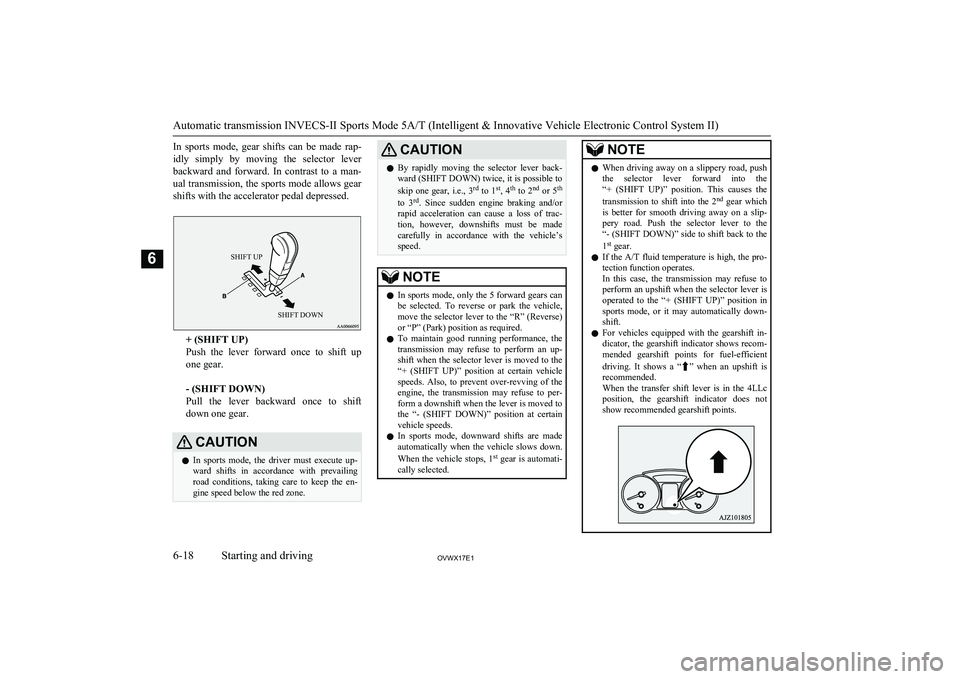
In sports mode, gear shifts can be made rap-idly simply by moving the selector leverbackward and forward. In contrast to a man-
ual transmission, the sports mode allows gear shifts with the accelerator pedal depressed.SHIFT UPSHIFT DOWN
+ (SHIFT UP)
Push the lever forward once to shift up
one gear.
- (SHIFT DOWN)
Pull the lever backward once to shift
down one gear.
CAUTIONl In sports mode, the driver must execute up-
ward shifts in accordance with prevailingroad conditions, taking care to keep the en-
gine speed below the red zone.CAUTIONl By rapidly moving the selector lever back-
ward (SHIFT DOWN) twice, it is possible to
skip one gear, i.e., 3 rd
to 1 st
, 4 th
to 2 nd
or 5 th
to 3 rd
. Since sudden engine braking and/or
rapid acceleration can cause a loss of trac-
tion, however, downshifts must be made carefully in accordance with the vehicle’s
speed.NOTEl In sports mode, only the 5 forward gears can
be selected. To reverse or park the vehicle, move the selector lever to the “R” (Reverse)
or “P” (Park) position as required.
l To maintain good running performance, the
transmission may refuse to perform an up- shift when the selector lever is moved to the
“+ (SHIFT UP)” position at certain vehicle speeds. Also, to prevent over-revving of the
engine, the transmission may refuse to per- form a downshift when the lever is moved to
the “- (SHIFT DOWN)” position at certain vehicle speeds.
l In sports mode, downward shifts are made
automatically when the vehicle slows down.
When the vehicle stops, 1st
gear is automati-
cally selected.NOTEl When driving away on a slippery road, push
the selector lever forward into the“+ (SHIFT UP)” position. This causes the
transmission to shift into the 2nd
gear which
is better for smooth driving away on a slip-
pery road. Push the selector lever to the
“- (SHIFT DOWN)” side to shift back to the
1 st
gear.
l If the
A/T fluid temperature is high, the pro-
tection function operates.
In this case, the transmission may refuse to perform an upshift when the selector lever is
operated to the “+ (SHIFT UP)” position in
sports mode, or it may automatically down- shift.
l For vehicles equipped with the gearshift in-
dicator, the gearshift indicator shows recom- mended gearshift points for fuel-efficient
driving. It shows a “
” when an upshift is
recommended.
When the transfer shift lever is in the 4LLc
position, the gearshift indicator does not show recommended gearshift points.
Automatic transmission INVECS-II Sports Mode 5A/T (Intelligent & Innovative Vehicle Electronic Control System II)
6-18OVWX17E1Starting and driving6
Page 157 of 394
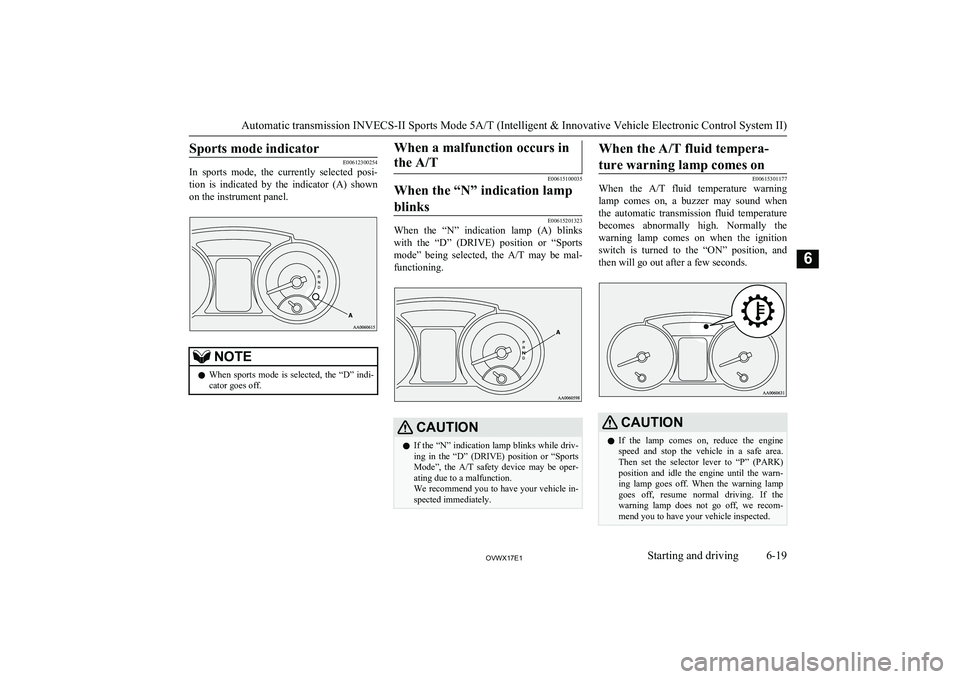
Sports mode indicator
E00612300254
In sports mode, the currently selected posi-
tion is indicated by the indicator (A) shown
on the instrument panel.NOTEl When sports mode is selected, the “D” indi-
cator goes off.When a malfunction occurs in
the A/T
E00615100035
When the “N” indication lamp
blinks
E00615201323
When the “N” indication lamp (A) blinks
with the “D” (DRIVE) position or “Sports mode” being selected, the A/T may be mal-
functioning.
CAUTIONl If the “N” indication lamp blinks while driv-
ing in the “D” (DRIVE) position or “Sports
Mode”, the A/T safety device may be oper-
ating due to a malfunction.
We recommend you to have your vehicle in-
spected immediately.When the A/T fluid tempera-
ture warning lamp comes on
E00615301177
When the A/T fluid temperature warning
lamp comes on, a buzzer may sound when the automatic transmission fluid temperature
becomes abnormally high. Normally the
warning lamp comes on when the ignition
switch is turned to the “ON” position, and then will go out after a few seconds.
CAUTIONl If the lamp comes on, reduce the engine
speed and stop the vehicle in a safe area.Then set the selector lever to “P” (PARK)
position and idle the engine until the warn-
ing lamp goes off. When the warning lamp goes off, resume normal driving. If the
warning lamp does not go off, we recom- mend you to have your vehicle inspected.
Automatic transmission INVECS-II Sports Mode 5A/T (Intelligent & Innovative Vehicle Electronic Control System II)
6-19OVWX17E1Starting and driving6
Page 158 of 394

Operation of the A/T
E00604200560
CAUTIONlBefore selecting a gear with the engine run-
ning and the vehicle stationary, fully depressthe brake pedal to prevent the vehicle from
creeping.
The vehicle will begin to move as soon as the gear is engaged, especially when the en-
gine speed is high, at fast idle or with the air conditioning operating, the brakes should
only be released when you are ready to drive
away.
l Depress the brake pedal with the right foot at
all times.
Using the left foot could cause driver move- ment delay in case of an emergency.
l Operating the accelerator pedal while the
other foot is resting on the brake pedal will affect braking efficiency and may cause pre-
mature wear of brake pads.
l To prevent sudden acceleration, never race
the engine when shifting from the “P”
(PARK) or “N” (NEUTRAL) position.
l Use the selector lever in the correct shift po-
sition in accordance with driving conditions. Never coast downhill backward with the se- lector lever in the “D” (DRIVE) or sportsmode position or coast forward with the se-
lector lever in the “R” (REVERSE) position. The engine may stop and the unexpected in- crease in brake pedal effort and steering
wheel weight could lead to an accident.CAUTIONl Do not race the engine with brake pedal
pressed when the vehicle is stationary.
This can damage the A/T.
Also, when you depress the accelerator ped- al while holding down the brake pedal withthe selector lever in the “P” (PARK), “N”
(NEUTRAL) or “D” (DRIVE) position, the
increase in engine revolutions may be limi-
ted.Passing acceleration
E00604500156
To gain extra acceleration in “D” (DRIVE)
position, push the accelerator to the floor.The automatic transmission will automatical- ly downshift.
NOTEl In “Sports mode”, downshifts do not take
place when the accelerator is depressed all
the way to the floor.Uphill/downhill driving
E00610500177
DRIVING UPHILL
The transmission prevents unnecessary up-
shifts even when the accelerator pedal is re- leased and ensures smooth driving.
DRIVING DOWNHILL
According to the conditions, the transmission
will automatically shift to a lower gear ratio to achieve stronger engine braking. This mayhelp reduce your need to use the service brake.
Waiting
E00604600245
For short waiting periods, such as at trafficsignals, the vehicle can be left in gear and held stationary with the service brake.
For longer waiting periods with the engine
running, place the selector lever in the “N” (NEUTRAL) position and apply the parking
brake, while holding the vehicle stationary with the service brake.
CAUTIONl Never hold the vehicle stationary on a hill
using the accelerator pedal (without using
the brake pedal). Always apply the parking brake and/or service brakes.Parking
E00604700161
To park the vehicle, first bring it to a com-
plete stop, fully engage the parking brake,and then move the selector lever to the “P”
(PARK) position.
Automatic transmission INVECS-II Sports Mode 5A/T (Intelligent & Innovative Vehicle Electronic Control System II)
6-20OVWX17E1Starting and driving6